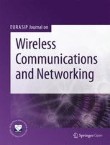EURASIP Journal on Wireless Communications and Networking welcomes submissions to the special issue on 'Evolutional Trends of Intelligent IoT in 5G Era'.
To exploit the huge potential market value of networked things, connecting and understanding objects rather than users has been driving the new wave of technological evolution. For example, a huge number of sensors and video cameras scatter in every corner of the city to gather different types of data. The sensed data is delivered through the Internet to control centers in different administrative sectors or vertical industries for improved service provision. The increasing wireless data requirements significantly exacerbate the problem of energy and spectrum shortage.
5G has emerged as the pivotal networking platform, where information is originated, delivered, processed and consumed. 5G IoT emphasizes compatible network architectures, improved provision of network services, efficient utilization of data and information, as well as close interaction with consumers. In particular, 5G adopts the model of massive machine type communications (mMTC), which is different from current human communication models by involving a potentially very large number of small and power-constrained devices with low volume of non-delay sensitive information.
In addition to mMTC, 5G new radio and NFV/SDN form the most efficient network architecture so far. It brings powerful nodes much closer to the scene by implementing edge/fog computing; it can also utilize network slicing and provide subscriber with isolated and service level agreement (SLA) guaranteed network services. As a result, subscribers will be able to achieve from integrated 5G IoT paradigm the ubiquitous access and flexible computational capability.
The vision is so appealing, but it remains the challenge of integrating 5G with related technologies. For example, how to use machine learning to enhance the ability of IoT platforms with efficient data analysis and effective decision making? Moreover, though 5G tends to form the foundation of intelligent IoT, it cannot accommodate all specific applications solely. The interoperability between 5G and other IoT solutions will be another challenging issue, which may lead to security and reliability concerns.
To overcome the challenges mentioned above, we propose this feature topic to help both academic and industrial research communities understand the recent research progress and emerging technologies of integrated 5G IoT.
Potential topics include but are not limited to:
- 5G network architecture for intelligent IoT
- 5G new radio enabled IoT
- Interoperability between 5G and other IoT solutions
- Commercial use cases of intelligent IoT over 5G
- Secure concerns and solutions for 5G IoT
- Machine learning based network slicing for IoT services
- SDN/NFV design for massive IoT connections
- Multi-access edge computing (MEC) and fog computing for Internet of things
Submission Instructions
Before submitting your manuscript, please ensure you have carefully read the submission guidelines for EURASIP Journal on Wireless Communications and Networking. The complete manuscript should be submitted through the EURASIP Journal on Wireless Communications and Networking submission system. To ensure that you submit to the correct special issue please select the appropriate special issue in the drop-down menu upon submission. In addition, indicate within your cover letter that you wish your manuscript to be considered as part of the special issue on 'Evolutional Trends of Intelligent IoT in 5G Era'. All submissions will undergo rigorous peer review and accepted articles will be published within the journal as a collection.
Deadline for submissions:
30 April 2021
Lead Guest Editor:
Bo Rong, Communications Research Centre Canada
Guest Editors:
William Liu, Auckland University of Technology, New Zealand
Michel Kadoch, École de technologie supérieure, Université du Québec, Canada
Ruidong Li, National Institute of Information and Communications Technology, Tokyo, Japan
Submissions will also benefit from the usual advantages of open access publication:
- Rapid publication: Online submission, electronic peer review and production make the process of publishing your article simple and efficient
- High visibility and international readership in your field: Open access publication ensures high visibility and maximum exposure for your work - anyone with online access can read your article
- No space constraints: Publishing online means unlimited space for figures, extensive data and video footage
- Authors retain copyright, licensing the article under a Creative Commons license: articles can be freely redistributed and reused as long as the article is correctly attributed
For editorial enquiries please contact vincent.salvo@springer.com.
Sign up for article alerts to keep updated on articles published in EURASIP Journal on Wireless Communications and Networking - including articles published in this special issue!
